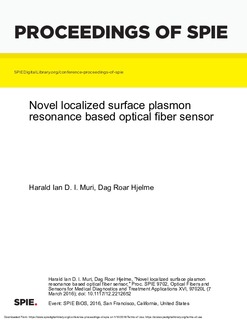Novel localized surface plasmon resonance based optical fiber sensor
Journal article, Peer reviewed
Published version

View/
Date
2016Metadata
Show full item recordCollections
Original version
Proceedings of SPIE, the International Society for Optical Engineering. 2016, 9702 . 10.1117/12.2212652Abstract
Over the last decade various optical fiber sensing schemes have been proposed based on local surface plasmon resonance (LSPR). LSPR are interacting with the evanescent field from light propagating in the fiber core or by interacting with the light at the fiber end face. Sensor designs utilizing the fiber end face is strongly preferred from a manufacturing point of view. However, the different techniques available to immobilize metallic nanostructures on the fiber end face for LSPR sensing is limited to essentially a monolayer, either by photolithographic structuring of metal film, thermal nucleation of metal film, or by random immobilization of nanoparticles (NP). In this paper, we report on a novel LSPR based optical fiber sensor architecture. The sensor is prepared by immobilizing gold NP’s in a hydrogel droplet polymerized on the fiber end face. This design has several advantages over earlier designs. It dramatically increase the number of NP’s available for sensing, it offers precise control over the NP density, and the NPs are position in a true 3D aqueous environment. The sensor design is also compatible with low cost manufacturing. The sensor design can measure volumetric changes in a stimuli-responsive hydrogel or measure binding to receptors on the NP surface. It can also be used as a two-parameter sensor by utilizing both effects. We present results from proof-of-concept experiments demonstrating a pH sensor based on LSPR sensing in a poly(acrylamide-co-acrylic acid) hydrogel embedding gold nanoparticles.